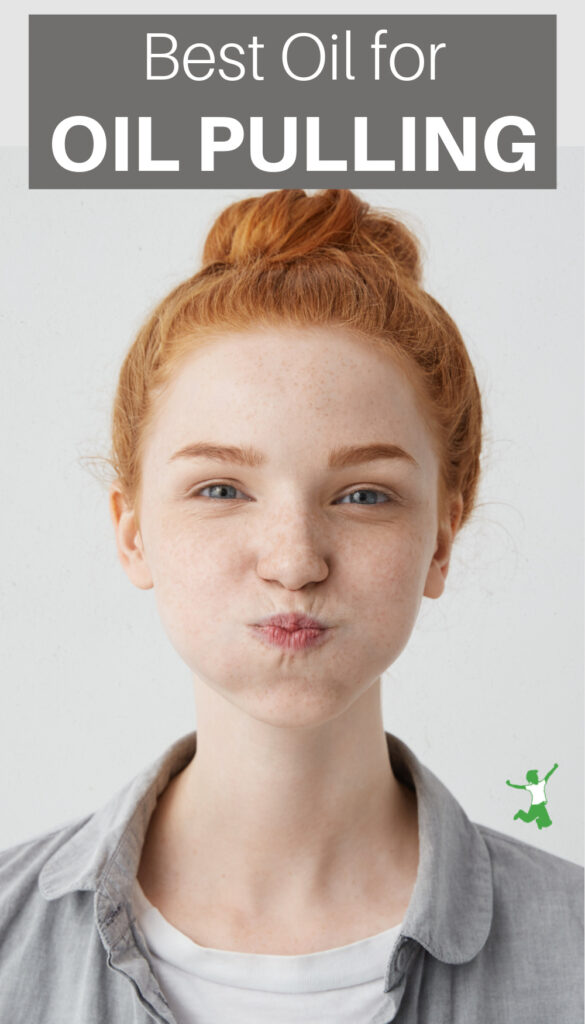The best oils to use for oil pulling for optimal benefits to oral health by eliminating toxins and pathogens from the gateway microbiome.

I first learned about oil pulling two decades ago while studying Ayurvedic cooking.
“Pulling” is an ancient detoxification therapy mentioned in ancient Ayurvedic texts and is recommended as an easy, daily practice.
Over time, “oil gargling” or “swishing” can drastically improve oral health and help resolve many chronic conditions such as periodontal (gum) disease and cavities. (1)
It can also be helpful for acute illness.
For example, oil pulling therapy has been touted as a strep throat remedy and helps resolve persistent sore throat issues.
Oil Pulling Health Benefits
The modern resurgence of this ancestral practice started in 1992 and was initiated by Dr. F. Karach, MD, who used it with great success in his medical practice.
Dr. Karach claimed that oil pulling would resolve a variety of illnesses including hormonal problems, cardiovascular disease, and digestive ailments. (2)
Dr. Bruce Fife, author of Coconut Cures and Oil Pulling Therapy: Detoxifying and Healing the Body Through Oral Cleansing, suggests that oil pulling therapy can effectively be used to clear and heal sinus problems. (3)
In fact, this is one of the first detox symptoms that are experienced is an increased flow/clearing of mucus from the throat and sinuses.
Mucous drainage is one of the body’s best methods of removing toxins.
How Does “Pulling” Work?
The practice of oil pulling is extremely simple.
Simply swish one tablespoon of raw, cold-pressed oil in the mouth for 15-20 minutes.
The swishing process involves gently pushing and pulling the oil around and through the teeth.
Try to oil pull at least once and up to three times per day on an empty stomach.
If you only do it once per day, the best time is first thing in the morning before breakfast or drinking anything. However, if you forget, any time of day before eating will do if necessary.
Dr. Fife advises the following while oil pulling:
While you are pulling, mucous may build in the back of your throat. You may even have to expel the oil and clear the mucous from your throat before reaching a full 20 minutes. That’s okay, take another spoonful of oil and continue until you’ve pulled for a total of 15-20 minutes. (4)
After swishing with the oil for the allotted amount of time, the oil is completely spat out and the teeth, gums, tongue, and palate are gently cleaned by rinsing the mouth with saltwater and brushing as usual.
Feel free to use a bit of sole water for this purpose if you have some on hand.
This next point may seem obvious, but it bears mentioning. It is important to never swallow or otherwise reuse the oil.
I think it is best to spit it out into the toilet rather than the sink because it contains toxins and bacteria and possibly even pus and mucous if an infection is present.
Which Oil is Best?
A variety of oils work very well for oil pulling.
Traditionally, unrefined sesame oil, coconut oil, or butter oil (ghee) were used.
The modern-day practice of this ancient therapy includes extra virgin olive oil or unrefined sunflower oil as alternatives as well.
While any one of these oils is likely effective, is any particular choice better than the others?
According to research performed by Irish scientists from the Athlone Institute of Technology who tested the effects of coconut oil, vegetable oil, and olive oil on dental health, the answer is yes.
Of the three types of oil tested, only coconut oil prevented tooth enamel damage by the pathogen Streptococcus mutans.
This acid-producing bacterium is a common inhabitant of the mouth and a major cause of tooth decay. (5)
This latest finding lends serious credibility to anecdotal claims that oil pulling works best with coconut oil.
Lead researcher Dr. Damien Brady stated that coconut oil could prove to be an attractive alternative to chemicals in maintaining oral health. (6)
He noted that not only does coconut oil work at relatively low concentrations but with the worrisome problem of increasing antibiotic resistance, it is important to consider coconut oil as a potentially novel new way to control microbial infections.
Dr. Fife also recommends making medicated coconut oil to enhance the effects and healing properties of oil pulling. (7)
Refined vs Unrefined
Virgin coconut oil (VCO) is the best choice for oil pulling therapy as it is truly “raw”.
This type of coconut oil is completely unheated with micronutrients and co-factors not present in refined versions. It is ideal for medicinal use.
Remember too, that coconut oil solidifies at 76 °F/24 °C, so if your virgin coconut oil is solid in the pantry, you may need to gently liquefy it in a pan of warm water first.
However, this step is not necessary if you are comfortable letting it melt in your mouth before you start swishing.
If you wish to supercharge the process, you can use ozonated coconut oil, which further enhances the anti-bacterial and anti-plaque benefits of oil pulling.
This therapeutic form of coconut oil is great for holistic dental flossing too and a practice recommended by biological dentists.
Bonus! Virgin coconut oil is an excellent oral antifungal as well.
Is Oil Pulling Right for You?
Oil pulling is probably the cheapest and easiest oral detoxification regimen you could ever try.
It simply involves swishing your mouth with unrefined oil one to three times a day on an empty stomach and then spitting it out.
No dieting, fasting, herbs, or pills are required to get started.
No matter what your age or level of health, oil pulling is harmless and nearly anyone can do it.
Sometimes powerful answers come in a brown paper bag.
Give oil pulling with virgin coconut oil a try!

(1) A review of holistic approaches to oral health
(2) Oil Pulling Therapy by Dr. Karach: Russian Folk Remedy
(3, 4, 7) Oil Pulling Therapy: Detoxifying and Healing the Body Through Oral Cleansing
(5, 6) Coconut oil can combat tooth decay, study suggests








Hello ,
Is it advisable to brush teeth before or after pulling ?
Brush after pulling. Oil pulling is ideally done first thing in the morning immediately after you rise and eat/drink anything.
I would like to know how oil pulling works thank you have a nice day
Apparently, toxins in the blood come out into the oil as it is swished in the mouth. The gum tissues are very very thin which permits easy exit for toxins from the blood into the oil. You swish for several minutes to allow as much blood as possible to travel through the blood vessels in the gum tissue and allow a maximum amount of toxins to be removed. That is why you must always spit the oil out when you are finished and never re-use.
Hi. Do you have an opinion about using Kazue Yamagishi Charcle Toothpaste? And if won’t hurt enamel how frequently should it be used? Thank you
I haven’t looked into it but not sure what this has to do with oil pulling.
We saved about 5k on dental bills from oil pulling and I have the lab work to prove it! However, I need to use a different kind of oil due to a current coconut allergy. Is there a second best oil to use which still have the anti-microbial properties? Thanks
Unrefined sesame oil would be a good choice. It is not as anti-microbial as coconut oil though.
Does oil pulling work for bad breath? Please answer genuinely whether its true that oil pulling kills bad breath.beacause bad breath is really embarrassing.
It can help.
It can help by eliminated bacteria in the mouth, but many times chronic issues with bad breath come from an imbalanced gut environment. For example, the keto diet is notorious for giving people issues with bad breath.
It can help by eliminating bad bacteria in the mouth over time. However, many times chronic bad breath issues stem from an imbalanced gut environment. For example, the keto diet is notorious for giving people issues with bad breath.
I’m curious about the recommendation that ghee may be used, as it’s often advised that cold-pressed oils are best. Surely ghee is highly heated? Wouldn’t grass-fed raw butter be a better alternative? (although I prefer coconut butter myself).
A more liquid fat is better … unrefined sesame oil or coconut oil (not coconut butter) is best.
I was listening yesterday to WP Podscat # 134, and I was surprised to hear that Coconut oil pulling, if done every day for a long period of time, can actually damage your oral health, since it would kill all bacteria in your mouth, the bad one and as well as the good one. Do you believe this is a true statement? If so, would sesam oil and/or olive oil have the same negative effect in the long run? Thank you in advance.
This is not true from the research I’ve read. If that were true, it would be bad for your gut bacteria if you ate it too, which is of course not accurate. Coconut oil is anti-microbial, but like garlic, does not harm beneficial bacteria. Colloidal silver, on the other hand, kills everything. I wouldn’t be swishing with that everyday.
Can anyone let me know: is it still effective if you use the kind of coconut oil that stays liquid?
Liquid coconut oil is not as good a choice because the most anti-microbial fatty acid (lauric acid) in the coconut oil has been removed. That is why it stays liquid. MCT oil is another name for liquid coconut oil. https://www.thehealthyhomeeconomist.com/mct-oil-the-coconut-oil-dregs/
The most disgusting thing I’ve ever read.
What brand name of coconut oil should I get and were from for oil pulling ,eg, supermarket ?